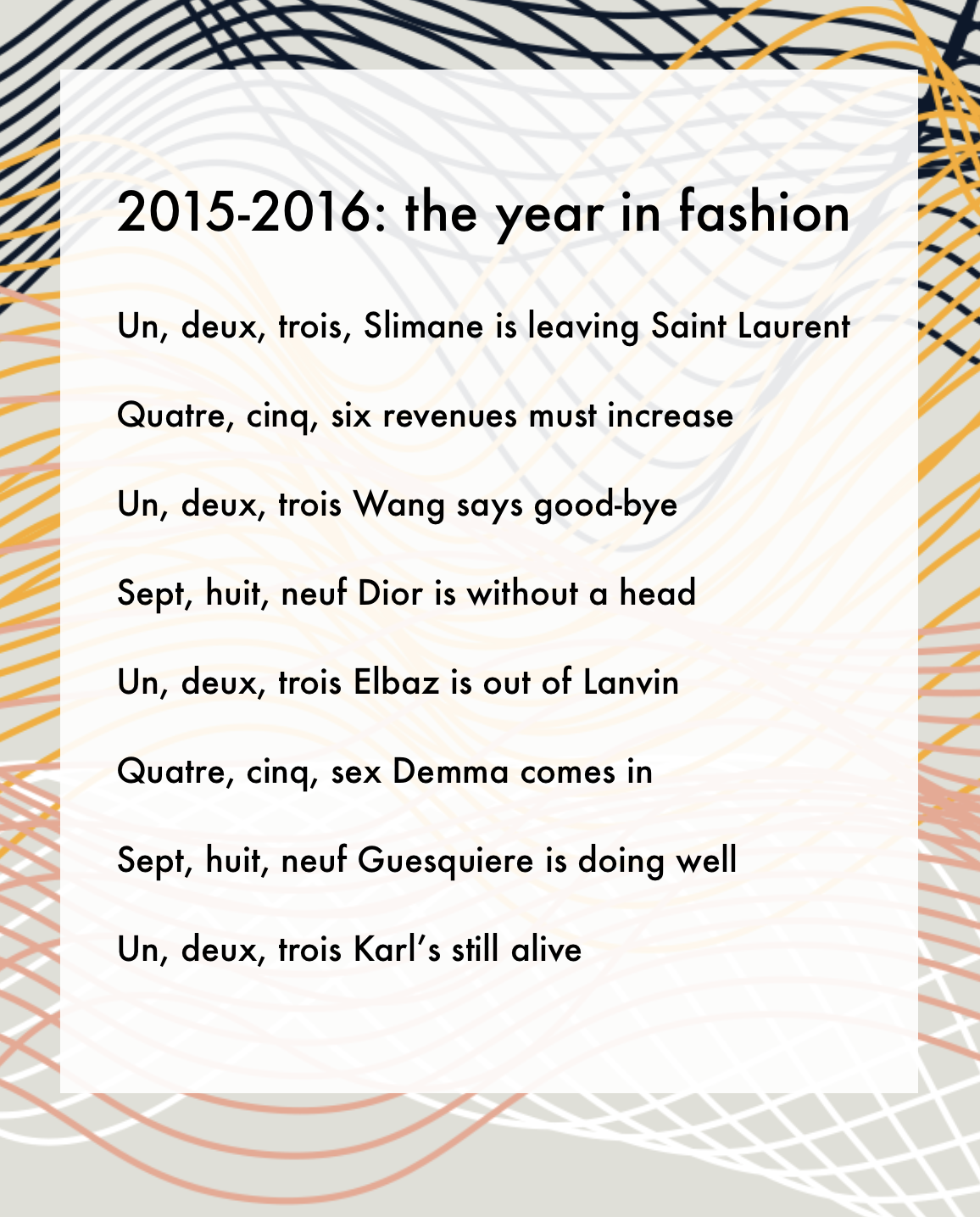Why Working in Fashion Was Kind of Great (And Not In The Way You Think)
For an industry with such notorious PR, the reputation of “working in fashion” could use some help. Who doesn’t conjure images of Meryl firing interns over incorrect coffee orders when they think about what it would be like to work at Vogue? And while there are things about fashion that totally suck (see: sweatshops, beauty standards, Photoshop, food policing, body shaming, office gossip, and low pay), there are things I miss about working in the fashion industry. It’s not the free clothes (I did manage to get some), or getting to go to fashion week (only because my friend had tickets), or working with people who have fabulous style (you know who you are), but it's working in a primarily female culture that I miss. I miss working with women.
I now work in a design-y tech job. Tech has some PR issues of its own, certainly. But a lot of tech companies make their employees feel prioritized, cared for, and special — including mine. They offer free food, unlimited vacation days, really, really good health benefits, a dog-friendly office (see my dog here), a burgeoning industry, and, you know, money! I made the jump from fashion to tech and I’m happy I did — I really like my job.
However, the fashion industry is a majority female culture, while tech tends to be male-dominated. It’s not that male-dominated cultures are all bad (I love guys! I’m dating one!), but I’ve been surprised by the rules and notions of professionalism that accompany these types of work environments. It’s the first time I experienced all of these “women in the workplace” issues I had only previously read about on Slate. When I first starting working on a predominantly male team, I noticed that I got interrupted often. People would repeat things I just said and take credit for them. I got hit on and then gaslit about it (“I wasn’t hitting on you!”). One month into my new job and I realized how much I took working in a female-dominated environment for granted.
Women aren’t perfect and working with women doesn’t solve everything, but it did solve a lot of things. This wasn’t because women complimented each other all the time (although that happened at least a dozen times a day), or because people checked in about each other’s feelings (also happened a dozen times a day), or because women chatted in the bathroom (also happened on a daily basis!). Rather it was because things that regularly happened to women were expected and welcomed and were not treated as inconveniences or “alternative” approaches to how one exists at work. The first office floor I worked on was about 80-90% women. And 80-90% of the bosses were women. That meant that at any given point people in power were pregnant, people in power were on maternity leave, people in power were leaving at six on the dot to go home. I was mentored by women. I was befriended by women. I was given raises by women. I was also gossiped about and back-stabbed and thrown under the bus. But I was never told I was too emotional. I was rarely interrupted, actually quite the opposite. There was a lot of “Oh, what were you saying?” “No, you go ahead.” I was never told I was being too much of a leader.
“I miss working in a female culture. I miss working with women.”
I currently work on a team that is about 75% men. The men I work with talk a lot about food. Most of the men I work with have asked me about my feelings maybe once or twice. A lot of the men I work with have taken six months before they share a personal fact about themselves or inquire about me at all. Some of the men I work with will get beers after work and stay out for hours. And these aren’t bad things! But these ways of operating at work and with co-workers are antithetical to the way I have been socialized most of my life. It took me a few months to put my finger on what was different. What was leaving me feeling like I was left out, and that I was missing some unspoken rules? After a few months, I realized that the pervasive notions of what was considered “professionalism” were inextricably tied to the normalized habits of offices full of men.
Men have been the vast majority of the professional workforce throughout history. So it makes sense that, in offices where men have predominantly been in charge, things traditionally considered “male” are deemed most appropriate, and often even required. And this doesn’t just happen with regard to gender. The underlying standards of professionalism are culturally white because offices and professional spaces have been comprised of mostly white people in the last 100 years (i.e. what is considered ‘professional communication’ is more aptly being recognized as racist grammar policing, or the fact that many black women have to take special precautions to make sure their hair is palatable to white notions of work-appropriateness). Notions of professionalism can be somewhat of an abstraction; however, the most insidious causes and perpetuations of social inequities are often like that: hard to put your finger on.
Gendered notions of professionalism are so omnipresent at work that it can be hard to recognize their full impact. Traditional women’s business clothes are pretty much just sexualized versions of the male suit —pull a work blouse a tad tighter and you have a costume from the opening scene of a porno. Traditionally professional female workwear perpetuates the idea that in order to operate in a work environment, women must heighten or give particular attention to their sexuality, underscoring society’s primary valuation of women in the very fibers of what they are required to wear. What would it look like if women had invented professional dress? If business clothes weren’t all derivatives of the suit? It’s hard to imagine a world where women established the norms of appropriate dress for all genders, yet that is what men got to do. Consider the truism that one shouldn’t bring their home life into their work life. That notion was created by men who typically had a wife at home running the house. These were segregated fields. As modern companies move towards offering more flexible hours and embracing a work-from-home culture, what would it look like to blur the lines of home and work to such an extent that it was able to fit the needs of women who are so deeply engaged in both arenas? Even the idea of promotions is based on a competitive ambition — a characteristic that is traditionally prized in men and chastised in women. What would it look like to have entire teams promoted as a way to financially reward collaboration?
New industries are disrupting traditional workplaces, yes, but it is still largely being done by straight, white, cis men who are getting to determine these new norms. Tech companies are filled with men who can wear hoodies and jeans five days a week while it would be considered completely inappropriate for women to come to work in yoga pants, or even, god forbid, without makeup on. (Think, “You look tired. Are you sick?”) This is why diverse representation is so important. It doesn’t matter how innovative a group of people is if there is only one type of person in the room. We need more women, people of color, and LGBTQ folks in leadership positions in the tech industry. And we needed them ten years ago.
Really, it’s about power and privilege (isn’t it always?). Those at the top reward those for following rules they have set in place. And when most of the folks who hold most of the power are men, they reward typical male traits, intentional or not. It’s not as if there are all these white men in suits sitting behind a big mahogany desk, rubbing their hands together maniacally and thinking about how to block women and people of color from rising in the workforce. But decades of male-dominated workforces have created requirements, regulations, and standards that disproportionately reward men (and usually the straight white ones). And the fashion industry, in my experience, is this little gem that I have had the privilege of working in where the male standard doesn’t mean so much.
“Gendered notions of professionalism are so omnipresent at work that it can be hard to recognize their full impact. ”
Women’s workplaces aren’t free of male expectations. While a lot of companies I’ve worked at are filled with mostly women, they are still run by men and founded by men, and thus are still subjected to male influence, power, and standards. But having an office full of women, particularly with women in leadership positions, was a beautiful tip of the scales. It was nice to work in a world where women held the majority of power. I have seen trans women, gay women, and women of color in leadership positions (albeit in a mostly white field with mostly white leaders) and it is this representation of so many different women leaders that has exploded my understanding of what it means to be a female boss. I wish everyone could have the opportunity to work in a mostly female office for a few months of their life to see a slightly different way of operating.
The good news is, the current office dynamics are changing. I recently got a female boss (hooray!) and there are way more women on my team now than even a year ago. The company for which I work is actively taking huge steps to increase diversity in my office. So, I think there is hope. Working in fashion offered me the peace of mind to know what it feels like to be part of the norm in an office setting. I felt known. And that is a really freeing and powerful feeling. I think that for society to progress, there should be an expansion of all spaces to include a wider variety of folks so that no one gender, race, or orientation gets to dominate the vibe. Working in a female space was like being in a cocoon -- I was safe and supported while the hardships of the world's office went on around me. I know that I can probably bring more change to professional cultures by being in one that needs more women in its workforce. I’m glad to be where I am, even if I miss catching up with friends in the bathroom and having co-workers ask me how I felt about the meeting we just had. I can try to be the change I want to see, taking up one office chair at a time.



